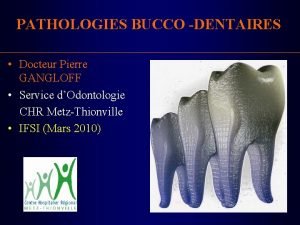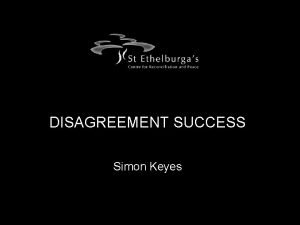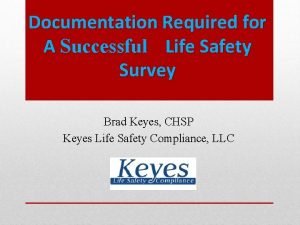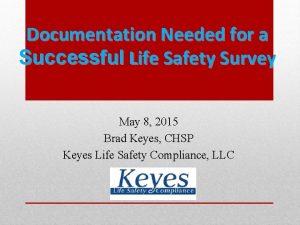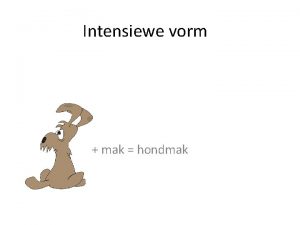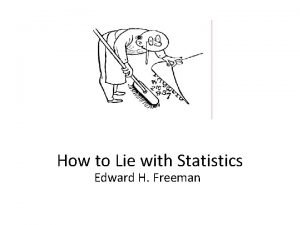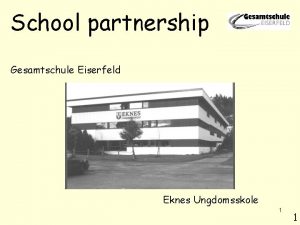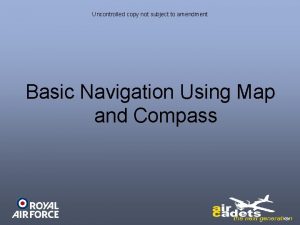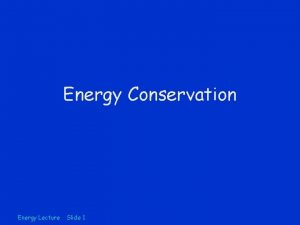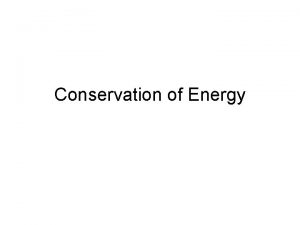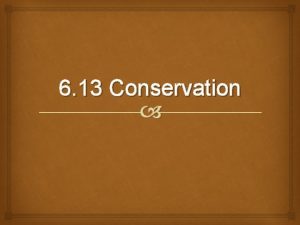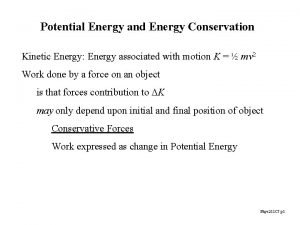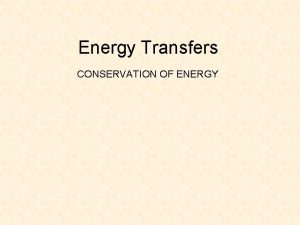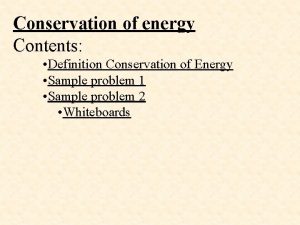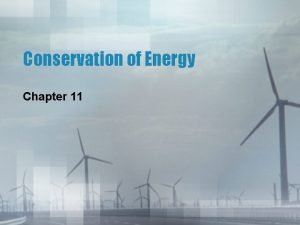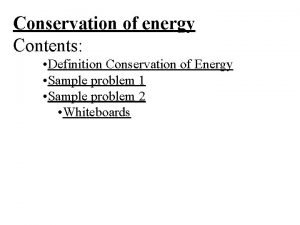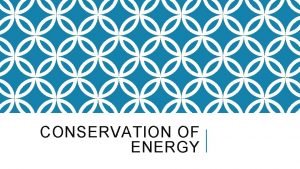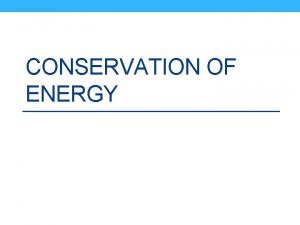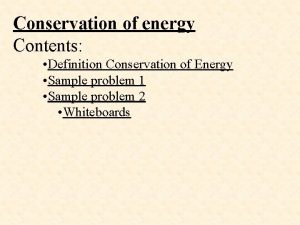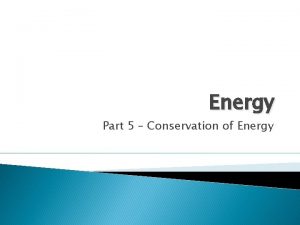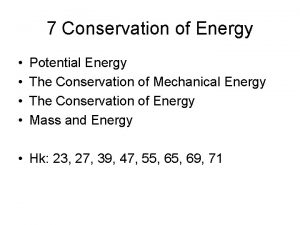Energy Conservation Keyes Mc Gee E I North



















- Slides: 19

Energy Conservation Keyes Mc. Gee, E. I. North Carolina Division of Pollution Prevention and Environmental Assistance Western North Carolina Recycler’s Networking Council Black Mountain, North Carolina December 9, 2004

Managing Energy Consumption ENERGY SAVING IS GOOD IF IT SAVES YOU MONEY. ENERGY SAVING IS BETTER IF IT MAKES YOU MONEY.

In what ways do you use electric power? t. Illumination. t. Heating, Cooling and Ventilating. t. Motors. t. Office Equipment.

How do you begin to conserve electric power? t Evaluate where you use the most energy. t Administration and Communication. t Utility Accounting. t Office Equipment. t New Construction. t Vehicle Use. t Lighting. t Space Conditioning – HVAC. t Building Envelope. t Miscellaneous Equipment.

All Of These Questions Are From This Document ! http: //www. landofsky. org/wrp/index. html

WRP Energy Guidance Utility Savings Initiative Fact Sheets Energy Self-Assessment Guide for Energy Savings Opportunities Electronic Self-Audit Tools WRP Lighting Efficiency Upgrade Tool Resource Manuals

EPA’s Waste Reduction Resource Center

Lighting Perspectives t. Consumes 24% of Commercial & Industrial Electricity t 90% of Lamps Produced are Incandescent t. Technology is Constantly Improving Principals for Maximizing Lighting Savings: 1. Illumination 2. Efficacy 3. Control

Light Source Efficacy Light Source Maintained Lumens Per Watt

Lighting Tips t. Inefficient bulbs create serious heat that can run up air conditioning costs. t. CLEANING fixtures once a year can save as much as 30% in room lighting. t. Is outdoor lighting being used well and inspected regularly? t. Old style EXIT Signs can cost $250 /year to run, while LED EXIT signs

The Easy Lighting Cost Savers t. CHOOSE LOWER LAMP WATTAGE. Today’s bulbs are brighter but use less wattage. t TURN OFF UN-NEEDED LIGHTS. t. USE TASK LIGHTING. It puts light where it is needed, saving wasted overhead lighting. t. INSTALL TIMERS AND MOTION SENSORS. Controls can SAVE 10% or more of lighting costs.

HVAC Systems t. Removes or Adds Heat t. Removes or Adds Humidity t. Provides Ventilation t. Cleans the Air HVAC Checklist t. Proper Equipment Application t. Efficiency Improving Hardware t. Operational Adjustments t. Maintenance Practices

Heating, Ventilation, and Air Conditioning (HVAC) t. HVAC systems have coils that need cleaning and/or filters that need changing. Dirty coils and filters cut efficiency and could create extra costs. t. HVAC Fan motors and drive belts need maintenance. A worn belt can mean 10% extra motor operating costs. t Look for heat sources under thermostats. Such as coffee pots or computers. t Use Zone and Automatic Controls.

Employee Power Saves Energy t Employee Common Sense makes all the difference in energy savings. t What employees and management know about energy saving helps then to spot energy waste. t Rewards and incentives remind employees to save energy. t Energy hours. saving practices often save work-

Energy Bills can LIE t Problems with meters could go undetected for years. t Compare electric bills with the same periods in previous years to detect costly hidden problems or practices. t Rate Schedules can be adjusted once a year to get the best rates, as equipment, practices, and circumstances change. t Rate Schedule fees and penalties can show something is wrong with your operation.

Energy Audit Process t Review t t t Billing History Two Year History - all sources Demand data when available Analyze building systems t t t Operational Hours Type of Equipment (i. e. chilled water cooling vs. rooftop AC) Age of Equipment Calculate load for major building systems t Review what systems are easiest to modify t

FREE Energy Audits are Available NC Division of Pollution Prevention and Environmental Assistance (DPPEA) 1 -800 -763 -0136 www. p 2 pays. org

DPPEA’s Website: P 2 PAYS. ORG

Energy Resources Waste Reduction Partners Energy Guidance: http: //www. landofsky. org/wrp/Other_Resourc es. htm EPA’s Waste Reduction Resource Center: http: //wrrc. p 2 pays. org/industry/energy. htm
 Medial patellofemoral ligament
Medial patellofemoral ligament Pathologies
Pathologies Simon keyes
Simon keyes Flowers for algernon full story online
Flowers for algernon full story online 2012 life safety code documentation checklist
2012 life safety code documentation checklist Brad keyes life safety
Brad keyes life safety Chapter 7 energy conservation of energy
Chapter 7 energy conservation of energy Wat is die intensiewe vorm van beroemd
Wat is die intensiewe vorm van beroemd Gee whiz graph
Gee whiz graph Gee
Gee Gee i wish i were a man poster
Gee i wish i were a man poster Erika gee
Erika gee Anthony walker forgiveness
Anthony walker forgiveness Gee panelist yale
Gee panelist yale Gesamtschule eiserfeld
Gesamtschule eiserfeld Heather pickard
Heather pickard True north vs magnetic north
True north vs magnetic north Cumbria and north east ics
Cumbria and north east ics Chapter 14 lesson 1
Chapter 14 lesson 1 The north pole ____ a latitude of 90 degrees north
The north pole ____ a latitude of 90 degrees north

